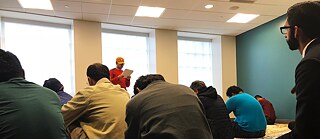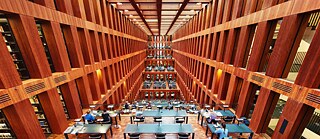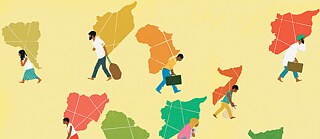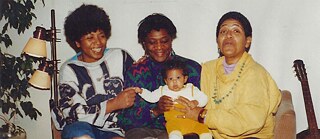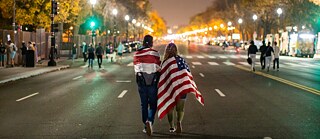Everyday life for Muslims in the U.S. and Germany
Being Muslim in the Midwest
What is it like to be Muslim in the Midwest? A look at shared experiences between Muslim communities in the U.S. and Germany, where many immigrants who practice Islam have arrived in recent years.
Listen to this episode: Apple Music | Spotify | Download
This episode is by Rosemary Pennington and Joe Sampson. Rosemary is an Assistant Professor of Journalism, and Joe is a Senior Clinical Lecturer of Journalism. Both work at Miami University in Oxford, Ohio. In this podcast, the producer duo chats with Muslim communities in Southwest Ohio, including the Muslim Student Association at Miami University, the Islamic Center of Greater Cincinnati, and CAIR regional offices. The song “Mystical Beauty” comes from Lobo Loco and is under a CC BY-NC-ND 4.0 license. Rosemary took the photo above, which shows members of the Muslim Student Association at Miami University during the Friday prayer.
Transcript
[MUSIC: “MYSTICAL BEAUTY” BY LOBO LOCO]
Ismaeel Chartier: I’ve found nothing but acceptance and love when we came to Cincinnati. I found people were willing to hear, willing to listen, willing to want to know more. It’s been very welcoming to the Muslim community that I can see.
Shatha Al-Azawi: I have two great neighbors here, who just stopped me in the street and say, “Don’t worry, we will support you.” And I was surprised. We never talked, you know. Just “good morning,” “hi, how’re you doing.” But I found them so supportive.
Helena: It’s like the first time where I’m really in a place where I feel like I’m — you know, the only minority.
Joe Sampson: According to the Pew Research Center, Islam is forecasted to be the world’s fastest growing religion in coming decades, with a projected Muslim population of three billion by 2060. Today, only about four and a half million of the world’s Muslims live in Germany, while a fraction call the United States home — with Pew estimating American Muslims to number about one percent of the nation’s total population.
Rosemary Pennington: While the majority of American Muslims live in big cities, like Los Angeles or Houston or Minneapolis, there are smaller Muslim communities scattered across the United States. Today, we introduce you to Muslims living in what’s considered America’s Heartland — the Midwest. I’m Rosemary Pennington.
Joe Sampson: And I’m Joe Sampson.
[CALL TO PRAYER]
Joe Sampson: On a Friday afternoon, the 600-square-foot meditation room on Miami University’s campus fills as Muslims come together for ‘Jumu’ah’ — the weekly prayer service. After settling into their places on prayer rugs spread across the floor, many bow their heads to listen to the weekly ‘Khutbah,’ or sermon.
[PREACHER DURING SERVICE: “IN TODAY’S WORLD WE ARE WITNESSING ATTEMPTS TO SMEAR ISLAM AND MUSLIMS.”]
Joe Sampson: Muslims on Miami’s Oxford, Ohio campus make up less than half a percent of the student body. How many Muslims work at the university — as faculty or staff — is unclear. The 25 or so individuals attending prayer this Friday represent only a fraction of Miami’s Muslim population.
Zafer Ozdemir: There are very few students who want to be identified as Muslim or come to Jumu’ah. There are probably — maybe seven to eight times more Muslims than what you see here.
Joe Sampson: Zafer Ozdemir is the faculty advisor to Miami’s Muslim Student Association, or M.S.A., which helps organize the Friday prayer service. Ozdemir has served as the M.S.A. faculty advisor for about eight years. The Information Systems professor and native of Turkey says when he first started working at the university 15 years ago, it was hard to connect to other Muslims in the small southwest Ohio town where the university is located.
Zafer Ozdemir: When I first came here, there would be maybe five people during Jumu’ah. As you saw, now there are 25, 30, so there’s been some growth. But when we first came, it was a shock — quite a shock.
Joe Sampson: Zaim Haq is the current student president of the M.S.A. at Miami. The pre-med biology major from Dayton, Ohio, says, finding a Muslim community on campus was important to him.
Zaim Haq: So, when I first came to Miami, I didn’t really expect there to be a really big Muslim population. Because, you know, the stereotypes and everything that you expect. Majority white campus, you know, all the parties and everything. So then, when I found there’s a sizeable population, that they have prayer here and everything — that was a welcome surprise.
Joe Sampson: But not everyone’s life as a Muslim student at Miami is quite so easy.
Helena: You know, Houston is very diverse. But here in Oxford, you know, everybody is kind of a bit the same. So, when I made that transition, it was kind of a bit of a shock for me.
Rosemary Pennington: Senior political science and anthropology major Helena sits in a crowded cafe on Miami University’s campus. Originally from the Democratic Republic of Congo, Helena moved with her family to Houston, Texas, when she was seven. A few years ago, Helena’s mom took a job in the Cincinnati area, and Helena followed her to the Midwest to study.
Helena: I didn’t know how my experience was going to be, so I was a bit afraid, because it’s the first time where I’m really in a place where I feel like, you know — I’m the only minority person, especially in classes.
Rosemary Pennington: Helena is black and black students only make up three percent of Miami’s student body. Wearing a maroon and gold hijab as she talks about her experience as a Muslim at Miami, it’s easy to see why she might worry about sticking out — she’s not only the only woman in hijab in the cafe, she’s also the only black person.
Helena: For me, people don’t see me as an authentic Muslim. They stereotype me and say that I’m part of Nation of Islam, so they don’t say that, “Oh, you know what, she’s a Muslim.” They’ll always say like, “Oh, you’re not an authentic Muslim, but you’re like the other type of Muslim, so you’re less of a threat. You’re still a threat because you’re black, but you’re less of a threat.”
Rosemary Pennington: Though navigating the public space of the university can be difficult for Helena, it’s not as difficult as it is for some of her friends, because she commutes — which she says, gives her the ability to go back to the safety of her community at the end of the day. Her friends living in dorms can’t do that, and some of them have had to deal with islamophobic treatment by fellow residents. Navigating the public space of the university can also be an issue for Muslim students in Germany: A 2009 study in the journal Social Anthropology found that Muslim university students often struggle to find spaces to pray or meet, and so they gather in whatever space they can find. That same study suggested the ability to be visibly Muslim and to engage in things like prayer services built up the self-confidence of Muslim university students in Germany. That struggle over space led the University of Hamburg to institute a religious code of conduct for its students.
Shatha Al-Azawi: For me, I didn’t see any harassment at all.
Rosemary Pennington: Back in Oxford, Shatha Al-Azawi knows all too well what it’s like to have to find space for oneself in a new environment.
Shatha Al-Azawi: It is a kind of strange feeling when you are leaving your home and just coming here, just like that. But after that, we just get more engaged with the community, and I found a job, and kids were going to school, and everything was good. I really like it now.
Rosemary Pennington: Shatha came to Miami with her husband, who is pursuing a PhD in chemistry. In Iraq, she was an English teacher, which she thinks helped her transition into life at the university a bit more easily than other spouses in her situation. Working with Miami’s Women’s Center, she helped organize the American and Muslim Collaboration Group. The group brings together non-Muslim and Muslim women so they can get to know one another, learn about their cultures, and work to move past stereotype. Shatha says the group’s World Hijab Day event has also helped create a space for understanding.
Shatha Al-Azawi: I invited my friends, who is not really connected to Miami, just friends through my job, I just know them through that. And one of them — she has girls, four girls — and she told me that before she knew me, she was afraid to see a Muslim woman who is wearing hijab. But after they visited me, they saw me in hijab, and I invited them to the World Hijab Day, and they even tried the hijab. And they were so happy and supported me.
Rosemary Pennington: Even with the feeling of support she’s experienced in Oxford, Shatha says, the town can sometimes feel small, and it can get tiring navigating it as a visible minority. Like Helena and several others we’ve spoken to, visiting mosques in West Chester or the Clifton area of Cincinnati can make people feel connected to a larger Muslim community.
[THE BIG POND ANTHEM PLAYING]
Joe Sampson: On a Wednesday morning in November, the Clifton Mosque in Cincinnati is quiet but for a group of workers positioned above the 13-year-old building, patching holes in the dome. It’s a physical reminder of a bombing that took place here in December 2005.
Ismaeel Chartier: The bombing made us realize that we needed allies.
Joe Sampson: That’s Ismaeel Chartier, the center’s imam. He was hired five years ago from a similar post in Denver. It’s his job to repair the lingering psychological damage following the bombing.
Ismaeel Chartier: Even though no one was harmed — it was only physical damage to the building — it still reminds us of the vulnerability that we have.
Joe Sampson: The center has spent $60,000 upgrading building security to include surveillance cameras and armed guards during Friday prayers.
Ismaeel Chartier: It’s not a matter of if, it’s a matter of when is this going to happen. When is somebody going to come here and do something? So, I think it’s an overwhelming fear that exists in the mind of a lot of Muslims in America right now.
Rosemary Pennington: In 2017, Germany’s Interior Ministry noted that almost 1,000 anti-Muslim crimes were committed in the country including the smearing of pig’s blood on mosques and the writing of Nazi symbols on mosque walls. However, the ministry suggests the number of anti-Muslim incidents dropped in 2018. That’s not the case in the U.S. where the Council on American-Islamic Relations, or CAIR, says more than 1,000 possible anti-Muslim incidents were reported to their office in just the second quarter of 2018.
Karen Dabdoub: Over the years, as Islamophobia has worsened in this country, we’re seeing more hate crimes and hate incidents. We’re seeing more attacks on mosques. We’re seeing more bullying of children, including by teachers.
Rosemary Pennington: Karen Dabdoub is the executive director of CAIR’s Cincinnati office. She says CAIR advocates for Muslims as well as works to educate the broader public about the diversity of the local Muslim community.
Karen Dabdoub: It’s diverse ethnically, linguistically, even religiously diverse as well. And even people who differ in terms of their adherence to the faith — you know, the whole spectrum from very conservative and very observant to very liberal and non-observant — just like any other religious community.
Rosemary Pennington: CAIR also works to educate that diverse group of people about their civil rights and to provide legal assistance when they face discrimination, or are the target of a hate crime. One of those people working to do that is Roula Allouch.
Roula Allouch: In these days, where people have such an increased level of hate and hatred towards Islam and Muslims, I like standing out as a Muslim. Even though I know that it puts me as a target, and it puts me in a situation where at times I am, unfortunately, perhaps in danger and I shouldn’t be. But as an American, as an attorney, and as a civil rights activist, I feel like it’s even more necessary to practice my First Amendment right to wear hijab.
Rosemary Pennington: Allouch is the National Board Chair of CAIR. The Cincinnati attorney says her activism and work on civil rights was partly spurred by the prejudice and misunderstanding she witnessed growing up. And while Islamophobia has a long history in the U.S., Allouch says, the recent increase in not only anti-Muslim sentiment but also anti-Muslim hate groups — according to the Southern Poverty Law Center — is something CAIR is watching closely.
Roula Allouch: It’s deeply disturbing, and I do think it is new in the way that it’s being put into practice. So, maybe the hate has always been there but now, like you said, it’s empowered. And not just empowered, but like there’s a stamp of approval from the highest office in our land to act in ways that are hateful and hurtful to many, many people in our country, including Muslims.
Rosemary Pennington: The American Muslim population represents a tiny fraction of the overall national population, but it is growing — with the Pew Research Center estimating Muslims will be the second largest religious group in the country after Christians by 2040. Even with such growth, Muslims would still only make up two percent of the US population. In Germany, Muslims now account for six percent of the population and it could be as high as 8.7 percent by 2050. As in the U.S., the German population is diverse — including established communities who immigrated from Turkey decades ago, as well as newer arrivals fleeing the war in Syria. The diverse backgrounds of Muslims in both the U.S. and Germany is a reminder that their experiences are diverse as well. It’s also an opportunity to embrace new ways of thinking.
Ismaeel Chartier: I think the greatest challenge is us, is Muslims themselves. Muslims have chosen to ostracize themselves from society. Whenever you ostracize yourself from society, society looks at you as a danger. “There’s something going on in there.” — “What are they doing in that building?” So, we’ve really tried to open up our experiences with the community. Not just allowing the community in to have full access to our centers, but also encouraging our parishioners to become full community members.
Joe Sampson: While there is no singular experience of being Muslim in the Midwest, all of the individuals we spoke with said it is becoming easier to connect to other Muslims in the region. Several also mentioned the importance of outreach efforts to non-Muslims in order to make local communities safe for everyone — Muslims and non-Muslims alike. And while anti-Muslim incidents are on the rise in the U.S., many of the Muslims featured in this story found cause for hope in the 2018 election.
Roula Allouch: We saw this past election the highest number of Muslims running for office ever in this country, which was really a beautiful statement in response to the hate that’s been coming against our community.
Rosemary Pennington: Reporting from southwest Ohio, I’m Rosemary Pennington.
Joe Sampson: And I’m Joe Sampson for THE BIG POND.
[MUSIC: “MYSTICAL BEAUTY” BY LOBO LOCO]



